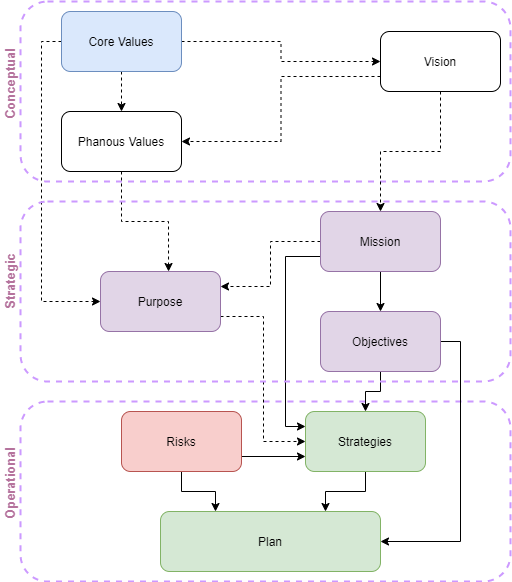¶ About the Katibeh
This is the master document which is intended to regulate most of the proceeding internal and external processes at Phanous Research and Innovation Centre. The intention is to create a single source of reference for decision making with respect to the management of Phanous Research and Innovation Centre. The document will be completed over time with feedback received from implementation of planned policies.

Figure 1 : The road-map for the R&D strategy plan. Dashed lines represent conceptual, and solid lines represent functional causalities
¶ Methodology
To write the Phanous Research and Innovation Centre R&D strategy plan we follow a three stage process comprising a Conceptual, Strategic, and Operational tiers. This process is illustrated in Figure 1. In Figure 1 the lines represent the flow of information across the stages and action sets. Dashed lines represent conceptual, and solid lines represent functional causalities.
In the Conceptual layer the chief objective is to determine the Phanous Research and Innovation Centre Vision Statementand any supplementary principles we wish to amend to the company core values. Since Phanous Research and Innovation Centre is a subsidiary of Hezardastan holding and is designed to generate value, the Vision Statement and Phanous Research and Innovation Centre Values should be inspired from, and consistent with the holding core values.
In the Strategic layer we consider the mission through which we can realize our longer term vision and then break this down into a set of objectives which when delivered in culmination, lead to the fulfillment of our mission in Phanous Research and Innovation Centre. We will also ask ourselves what do we consider to be primary purposes of this R&D strategy plan in the short term and longer term future of Phanous Research and Innovation Centre?
In the Operational layer we shall identify the major risks associated with the operations of Phanous Research and Innovation Centre. Then, by considering the outcomes of the strategic layer, we propose a set of specific action strategies which we believe will deliver our objectives, mitigate the risks, and fulfill our primary purposes for this plan.
¶ Scope
The scope of this R&D strategy plan is broken down into 4 strategic fields: architecture , processes , people , and portfolio. Together, decisions made in each of these categories constitute the R&D strategy.
Architecture refers to the set of decisions around how R&D is structured both organizationally and geographically. This category includes decisions such as centralization vs. decentralization of R&D; the size, location, and focus of R&D units; whether R&D units report to business units or are autonomous; whether research is organizationally separated from development; and the degree to which R&D utilizes external resources and partnerships.
Processes are the formal and informal ways that R&D is carried out. This category includes choices about project management systems, the governance of projects (including the nature of senior management reviews), the sequence and flow of critical project tasks, the timing of reviews, and the metrics and indicators used to track projects.
People are an enormously important aspects of an R&D system. Despite the growing use of sophisticated instrumentation, computer simulation, and laboratory automation, R&D is still a labor intensive process. Choices about human resources; such as the mix of generalists vs. specialists, technical backgrounds and training, work styles, career paths, lay off policies, etc. are significantly important.
Portfolio refers to the desired resource allocation across different types of R&D projects and the criteria used to sort, prioritize, and select projects. The R&D portfolio reflects the priorities of the R&D strategy.
¶ Where to Next?
- About us Find out about our vision and mission
- Values Find out about our core values
- Purposes Read about the purposes of the Katibeh
- Objectives Find out what are our objectives from creating Phanous
- Risks Learn more about the main risks affecting Phanous
- Strategies Read about what are our research and developments strategies and why
- Action Plans Learn about the Phanous research and development strategy action plan
- Download Download The Katibeh as a single doc
¶ Bibliography
The following referecnes have been used in prepration of the Katibeh
[1] Scott A. Mastroianni. Risk management among research and development projects. Theses and dissertations, Lehigh University, 2011.
[2] Amin Nobakhti. Project asimov: Objectives and Costs, March 2019.
[3] Gary P. Pisano.Creating an R&D Strategy. Harvard Business School, April 2012. Working Paper.
[4] Edward R. Tufte.Envisioning Information. Graphics Press, Cheshire, Connecticut, 1990. ISBN 0 - 9613921 - 1 - 8.
[5] Edward R. Tufte. Visual Explanations. Graphics Press, Cheshire, Connecticut, 1997. ISBN 0 - 9613921 - 2 - 6.
[6] Edward R. Tufte. The Visual Display of Quantitative Information. Graphics Press, Cheshire, Connecticut, 2001. ISBN 0 - 9613921 - 4 - 2.
[7] Edward R. Tufte. Beautiful Evidence. Graphics Press, LLC, first edition, May 2006. ISBN 0 - 9613921 - 7 - 7.